Hijab Fashion Brand: International Market Strategy & Analysis
VerifiedAdded on 2023/06/03
|6
|1526
|354
Report
AI Summary
This report provides an analysis of the local and international market for a new hijab fashion brand, addressing the opportunities and challenges in both the Australian and global markets. It emphasizes the importance of understanding cultural and social factors, particularly within the Muslim community, and suggests strategies for entering the international market, including a SWOT analysis and the 4Ps of marketing (product, price, promotion, and place). The report highlights the growing trend of modest fashion and the potential for reaching both Muslim and non-Muslim consumers, while also acknowledging the competitive landscape and the need for a unique brand identity and high-quality products. Ultimately, it advises the designer to build a community around the brand, leverage influencer marketing, and create engaging content to effectively reach and resonate with the target audience.
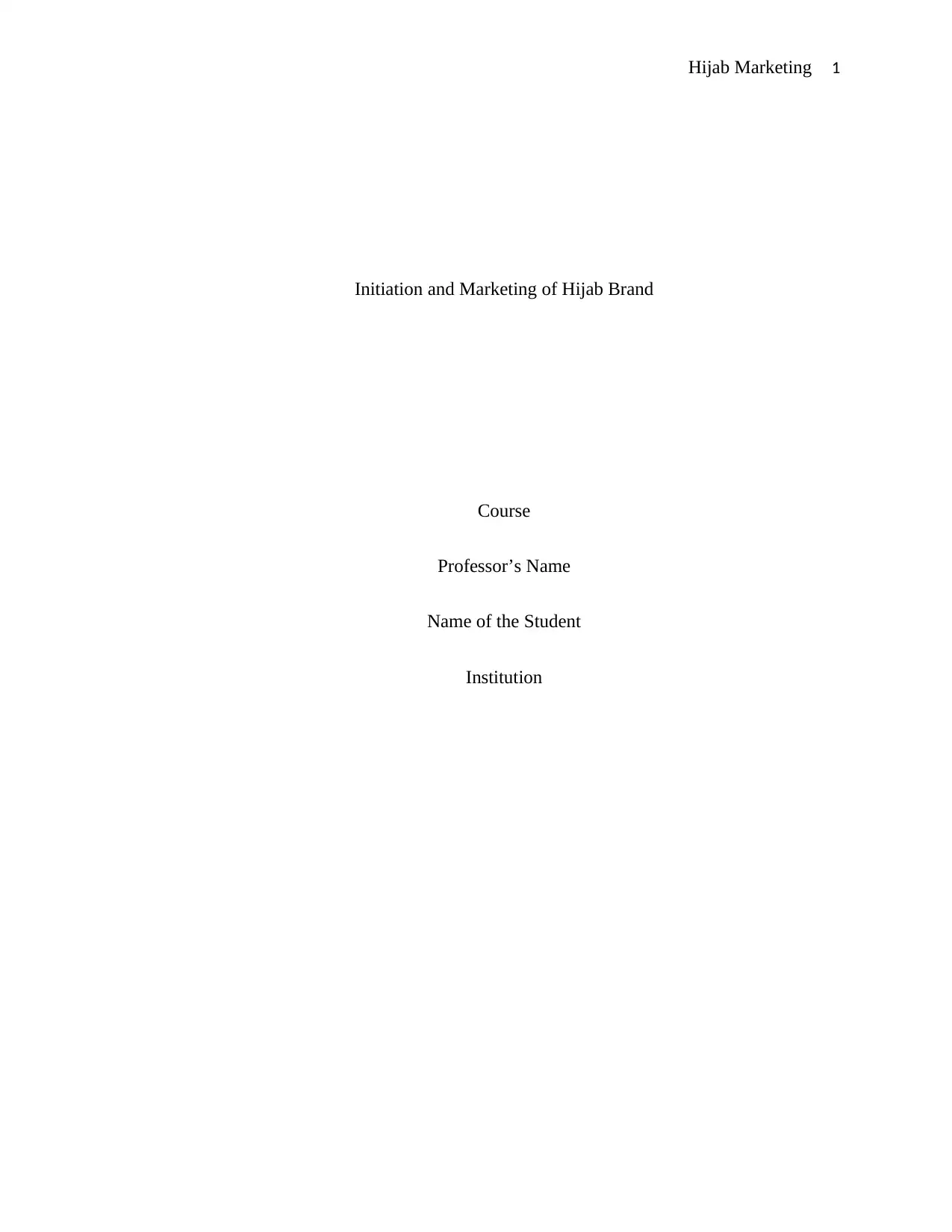
Hijab Marketing 1
Initiation and Marketing of Hijab Brand
Course
Professor’s Name
Name of the Student
Institution
Initiation and Marketing of Hijab Brand
Course
Professor’s Name
Name of the Student
Institution
Paraphrase This Document
Need a fresh take? Get an instant paraphrase of this document with our AI Paraphraser
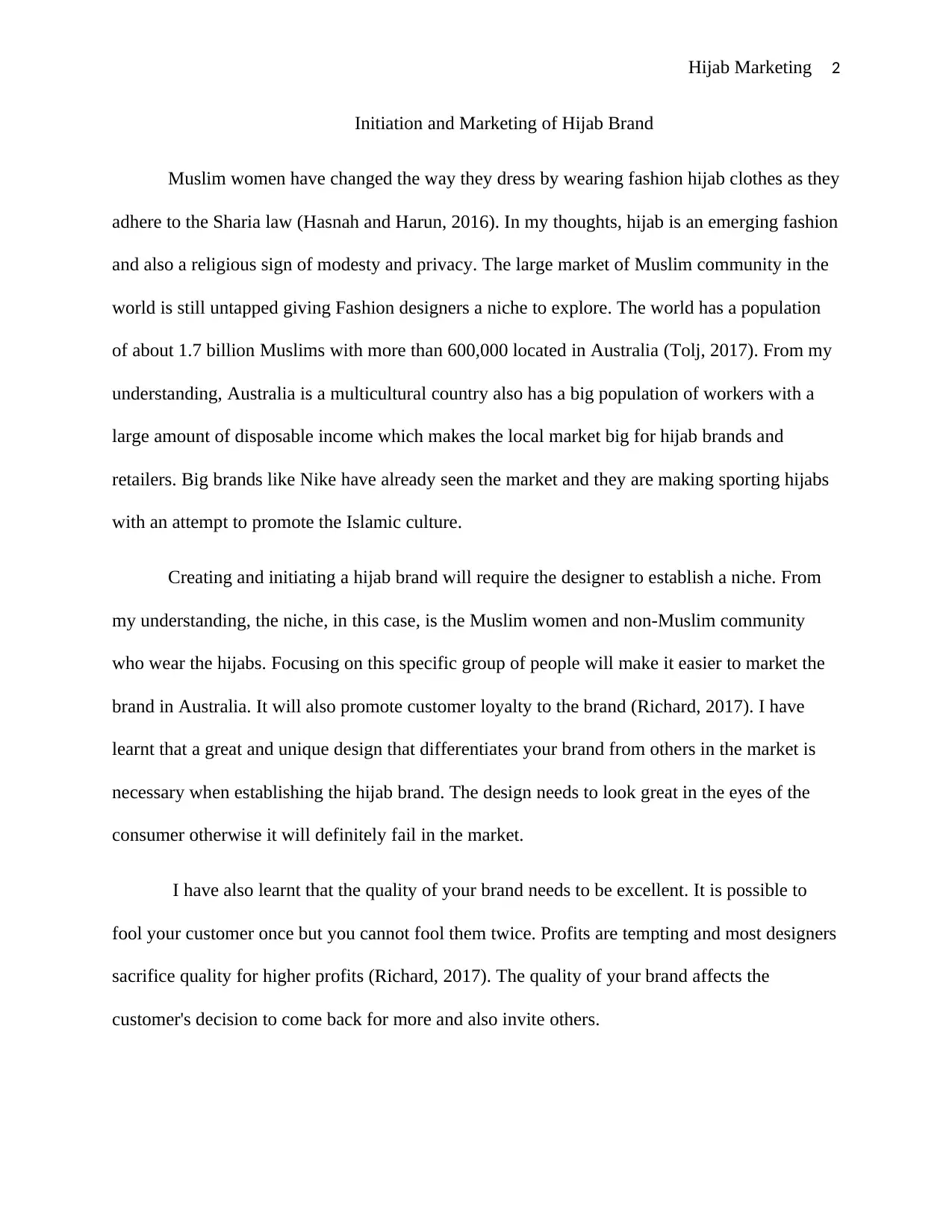
Hijab Marketing 2
Initiation and Marketing of Hijab Brand
Muslim women have changed the way they dress by wearing fashion hijab clothes as they
adhere to the Sharia law (Hasnah and Harun, 2016). In my thoughts, hijab is an emerging fashion
and also a religious sign of modesty and privacy. The large market of Muslim community in the
world is still untapped giving Fashion designers a niche to explore. The world has a population
of about 1.7 billion Muslims with more than 600,000 located in Australia (Tolj, 2017). From my
understanding, Australia is a multicultural country also has a big population of workers with a
large amount of disposable income which makes the local market big for hijab brands and
retailers. Big brands like Nike have already seen the market and they are making sporting hijabs
with an attempt to promote the Islamic culture.
Creating and initiating a hijab brand will require the designer to establish a niche. From
my understanding, the niche, in this case, is the Muslim women and non-Muslim community
who wear the hijabs. Focusing on this specific group of people will make it easier to market the
brand in Australia. It will also promote customer loyalty to the brand (Richard, 2017). I have
learnt that a great and unique design that differentiates your brand from others in the market is
necessary when establishing the hijab brand. The design needs to look great in the eyes of the
consumer otherwise it will definitely fail in the market.
I have also learnt that the quality of your brand needs to be excellent. It is possible to
fool your customer once but you cannot fool them twice. Profits are tempting and most designers
sacrifice quality for higher profits (Richard, 2017). The quality of your brand affects the
customer's decision to come back for more and also invite others.
Initiation and Marketing of Hijab Brand
Muslim women have changed the way they dress by wearing fashion hijab clothes as they
adhere to the Sharia law (Hasnah and Harun, 2016). In my thoughts, hijab is an emerging fashion
and also a religious sign of modesty and privacy. The large market of Muslim community in the
world is still untapped giving Fashion designers a niche to explore. The world has a population
of about 1.7 billion Muslims with more than 600,000 located in Australia (Tolj, 2017). From my
understanding, Australia is a multicultural country also has a big population of workers with a
large amount of disposable income which makes the local market big for hijab brands and
retailers. Big brands like Nike have already seen the market and they are making sporting hijabs
with an attempt to promote the Islamic culture.
Creating and initiating a hijab brand will require the designer to establish a niche. From
my understanding, the niche, in this case, is the Muslim women and non-Muslim community
who wear the hijabs. Focusing on this specific group of people will make it easier to market the
brand in Australia. It will also promote customer loyalty to the brand (Richard, 2017). I have
learnt that a great and unique design that differentiates your brand from others in the market is
necessary when establishing the hijab brand. The design needs to look great in the eyes of the
consumer otherwise it will definitely fail in the market.
I have also learnt that the quality of your brand needs to be excellent. It is possible to
fool your customer once but you cannot fool them twice. Profits are tempting and most designers
sacrifice quality for higher profits (Richard, 2017). The quality of your brand affects the
customer's decision to come back for more and also invite others.
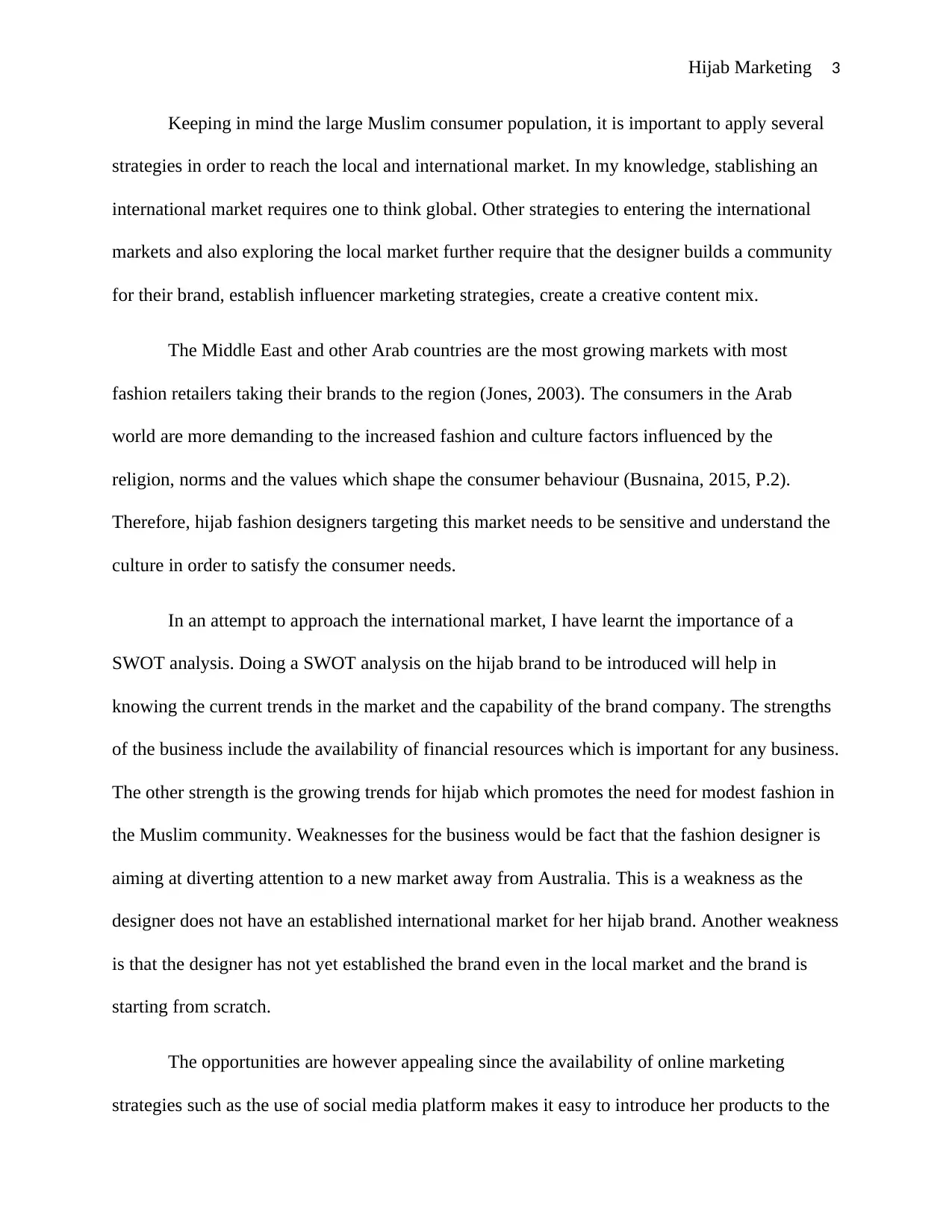
Hijab Marketing 3
Keeping in mind the large Muslim consumer population, it is important to apply several
strategies in order to reach the local and international market. In my knowledge, stablishing an
international market requires one to think global. Other strategies to entering the international
markets and also exploring the local market further require that the designer builds a community
for their brand, establish influencer marketing strategies, create a creative content mix.
The Middle East and other Arab countries are the most growing markets with most
fashion retailers taking their brands to the region (Jones, 2003). The consumers in the Arab
world are more demanding to the increased fashion and culture factors influenced by the
religion, norms and the values which shape the consumer behaviour (Busnaina, 2015, P.2).
Therefore, hijab fashion designers targeting this market needs to be sensitive and understand the
culture in order to satisfy the consumer needs.
In an attempt to approach the international market, I have learnt the importance of a
SWOT analysis. Doing a SWOT analysis on the hijab brand to be introduced will help in
knowing the current trends in the market and the capability of the brand company. The strengths
of the business include the availability of financial resources which is important for any business.
The other strength is the growing trends for hijab which promotes the need for modest fashion in
the Muslim community. Weaknesses for the business would be fact that the fashion designer is
aiming at diverting attention to a new market away from Australia. This is a weakness as the
designer does not have an established international market for her hijab brand. Another weakness
is that the designer has not yet established the brand even in the local market and the brand is
starting from scratch.
The opportunities are however appealing since the availability of online marketing
strategies such as the use of social media platform makes it easy to introduce her products to the
Keeping in mind the large Muslim consumer population, it is important to apply several
strategies in order to reach the local and international market. In my knowledge, stablishing an
international market requires one to think global. Other strategies to entering the international
markets and also exploring the local market further require that the designer builds a community
for their brand, establish influencer marketing strategies, create a creative content mix.
The Middle East and other Arab countries are the most growing markets with most
fashion retailers taking their brands to the region (Jones, 2003). The consumers in the Arab
world are more demanding to the increased fashion and culture factors influenced by the
religion, norms and the values which shape the consumer behaviour (Busnaina, 2015, P.2).
Therefore, hijab fashion designers targeting this market needs to be sensitive and understand the
culture in order to satisfy the consumer needs.
In an attempt to approach the international market, I have learnt the importance of a
SWOT analysis. Doing a SWOT analysis on the hijab brand to be introduced will help in
knowing the current trends in the market and the capability of the brand company. The strengths
of the business include the availability of financial resources which is important for any business.
The other strength is the growing trends for hijab which promotes the need for modest fashion in
the Muslim community. Weaknesses for the business would be fact that the fashion designer is
aiming at diverting attention to a new market away from Australia. This is a weakness as the
designer does not have an established international market for her hijab brand. Another weakness
is that the designer has not yet established the brand even in the local market and the brand is
starting from scratch.
The opportunities are however appealing since the availability of online marketing
strategies such as the use of social media platform makes it easy to introduce her products to the
⊘ This is a preview!⊘
Do you want full access?
Subscribe today to unlock all pages.

Trusted by 1+ million students worldwide
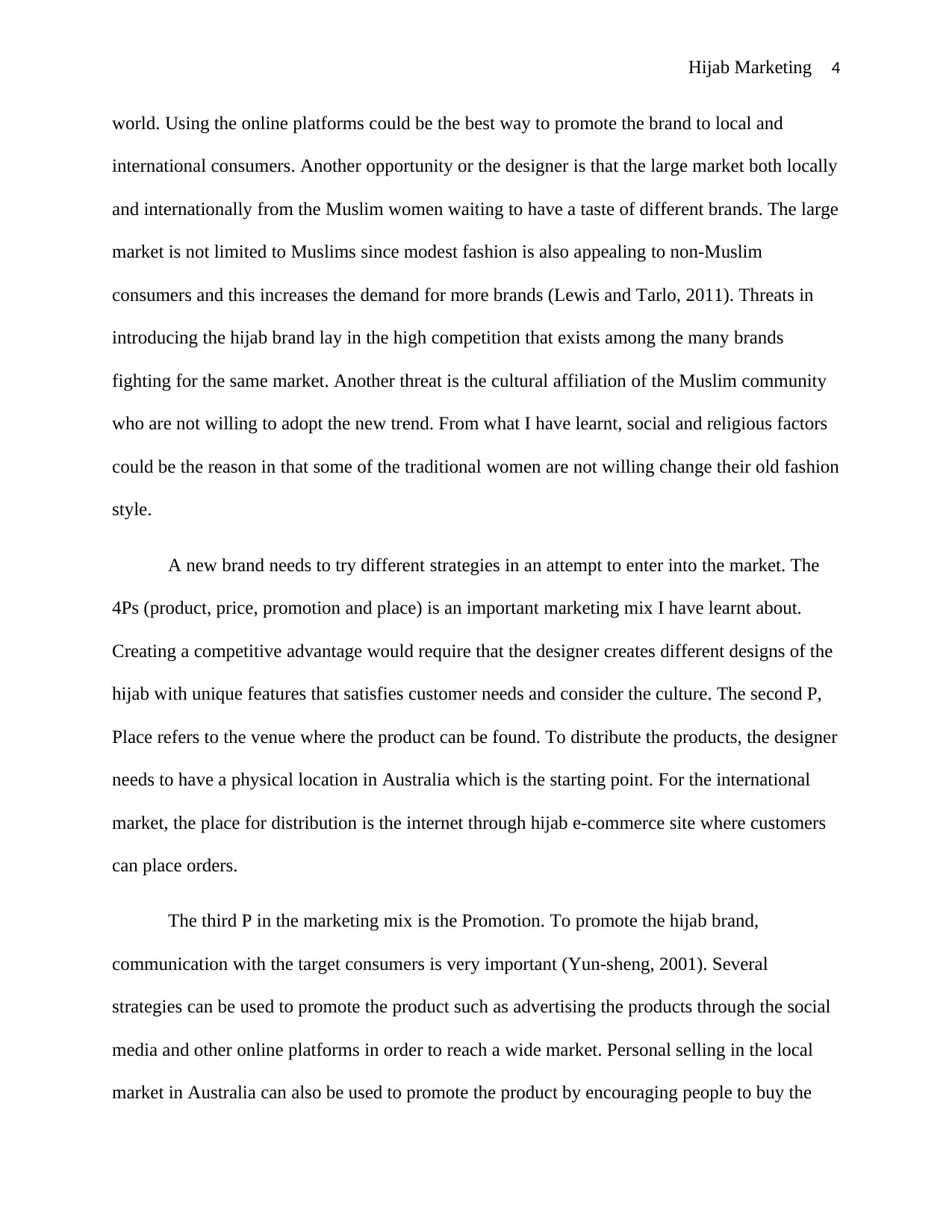
Hijab Marketing 4
world. Using the online platforms could be the best way to promote the brand to local and
international consumers. Another opportunity or the designer is that the large market both locally
and internationally from the Muslim women waiting to have a taste of different brands. The large
market is not limited to Muslims since modest fashion is also appealing to non-Muslim
consumers and this increases the demand for more brands (Lewis and Tarlo, 2011). Threats in
introducing the hijab brand lay in the high competition that exists among the many brands
fighting for the same market. Another threat is the cultural affiliation of the Muslim community
who are not willing to adopt the new trend. From what I have learnt, social and religious factors
could be the reason in that some of the traditional women are not willing change their old fashion
style.
A new brand needs to try different strategies in an attempt to enter into the market. The
4Ps (product, price, promotion and place) is an important marketing mix I have learnt about.
Creating a competitive advantage would require that the designer creates different designs of the
hijab with unique features that satisfies customer needs and consider the culture. The second P,
Place refers to the venue where the product can be found. To distribute the products, the designer
needs to have a physical location in Australia which is the starting point. For the international
market, the place for distribution is the internet through hijab e-commerce site where customers
can place orders.
The third P in the marketing mix is the Promotion. To promote the hijab brand,
communication with the target consumers is very important (Yun-sheng, 2001). Several
strategies can be used to promote the product such as advertising the products through the social
media and other online platforms in order to reach a wide market. Personal selling in the local
market in Australia can also be used to promote the product by encouraging people to buy the
world. Using the online platforms could be the best way to promote the brand to local and
international consumers. Another opportunity or the designer is that the large market both locally
and internationally from the Muslim women waiting to have a taste of different brands. The large
market is not limited to Muslims since modest fashion is also appealing to non-Muslim
consumers and this increases the demand for more brands (Lewis and Tarlo, 2011). Threats in
introducing the hijab brand lay in the high competition that exists among the many brands
fighting for the same market. Another threat is the cultural affiliation of the Muslim community
who are not willing to adopt the new trend. From what I have learnt, social and religious factors
could be the reason in that some of the traditional women are not willing change their old fashion
style.
A new brand needs to try different strategies in an attempt to enter into the market. The
4Ps (product, price, promotion and place) is an important marketing mix I have learnt about.
Creating a competitive advantage would require that the designer creates different designs of the
hijab with unique features that satisfies customer needs and consider the culture. The second P,
Place refers to the venue where the product can be found. To distribute the products, the designer
needs to have a physical location in Australia which is the starting point. For the international
market, the place for distribution is the internet through hijab e-commerce site where customers
can place orders.
The third P in the marketing mix is the Promotion. To promote the hijab brand,
communication with the target consumers is very important (Yun-sheng, 2001). Several
strategies can be used to promote the product such as advertising the products through the social
media and other online platforms in order to reach a wide market. Personal selling in the local
market in Australia can also be used to promote the product by encouraging people to buy the
Paraphrase This Document
Need a fresh take? Get an instant paraphrase of this document with our AI Paraphraser
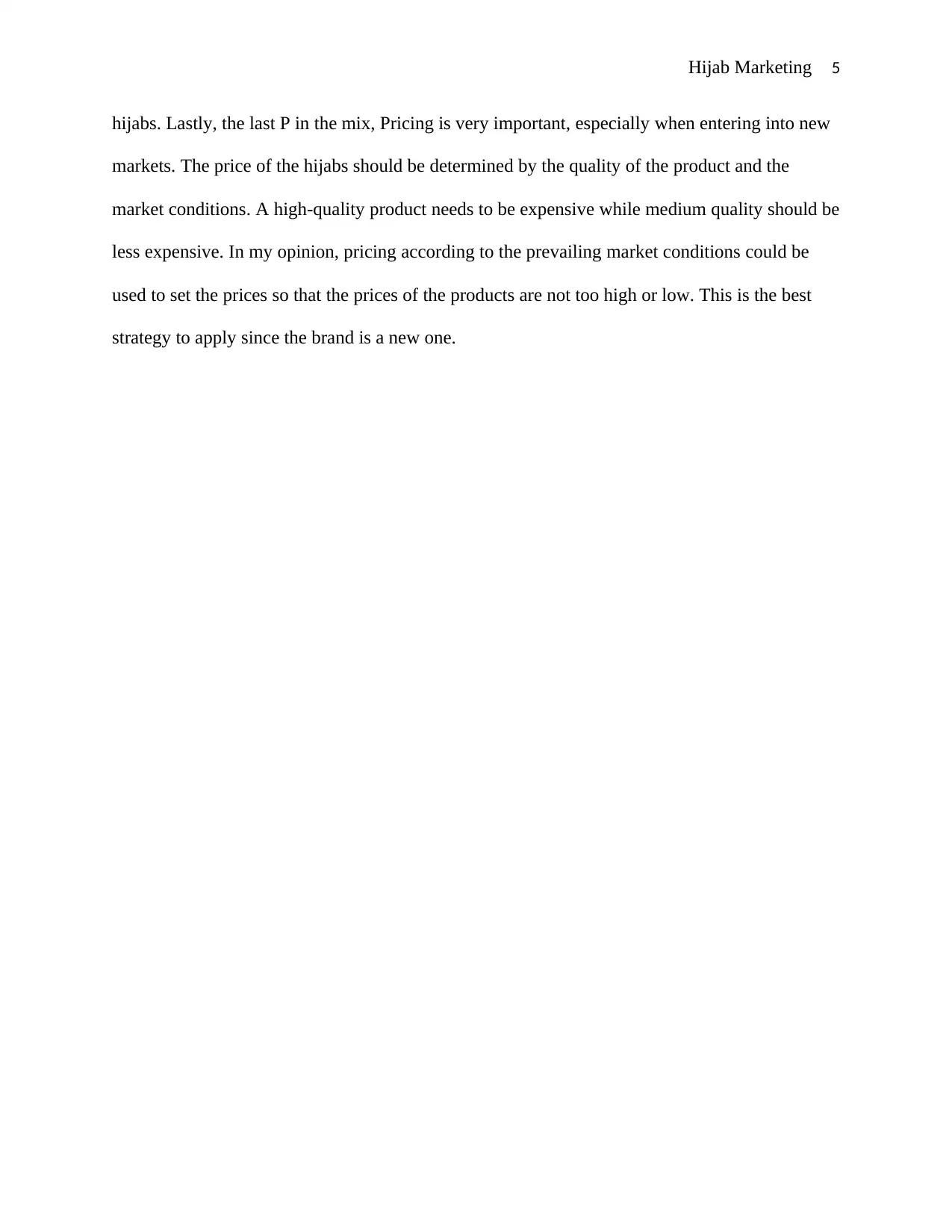
Hijab Marketing 5
hijabs. Lastly, the last P in the mix, Pricing is very important, especially when entering into new
markets. The price of the hijabs should be determined by the quality of the product and the
market conditions. A high-quality product needs to be expensive while medium quality should be
less expensive. In my opinion, pricing according to the prevailing market conditions could be
used to set the prices so that the prices of the products are not too high or low. This is the best
strategy to apply since the brand is a new one.
hijabs. Lastly, the last P in the mix, Pricing is very important, especially when entering into new
markets. The price of the hijabs should be determined by the quality of the product and the
market conditions. A high-quality product needs to be expensive while medium quality should be
less expensive. In my opinion, pricing according to the prevailing market conditions could be
used to set the prices so that the prices of the products are not too high or low. This is the best
strategy to apply since the brand is a new one.
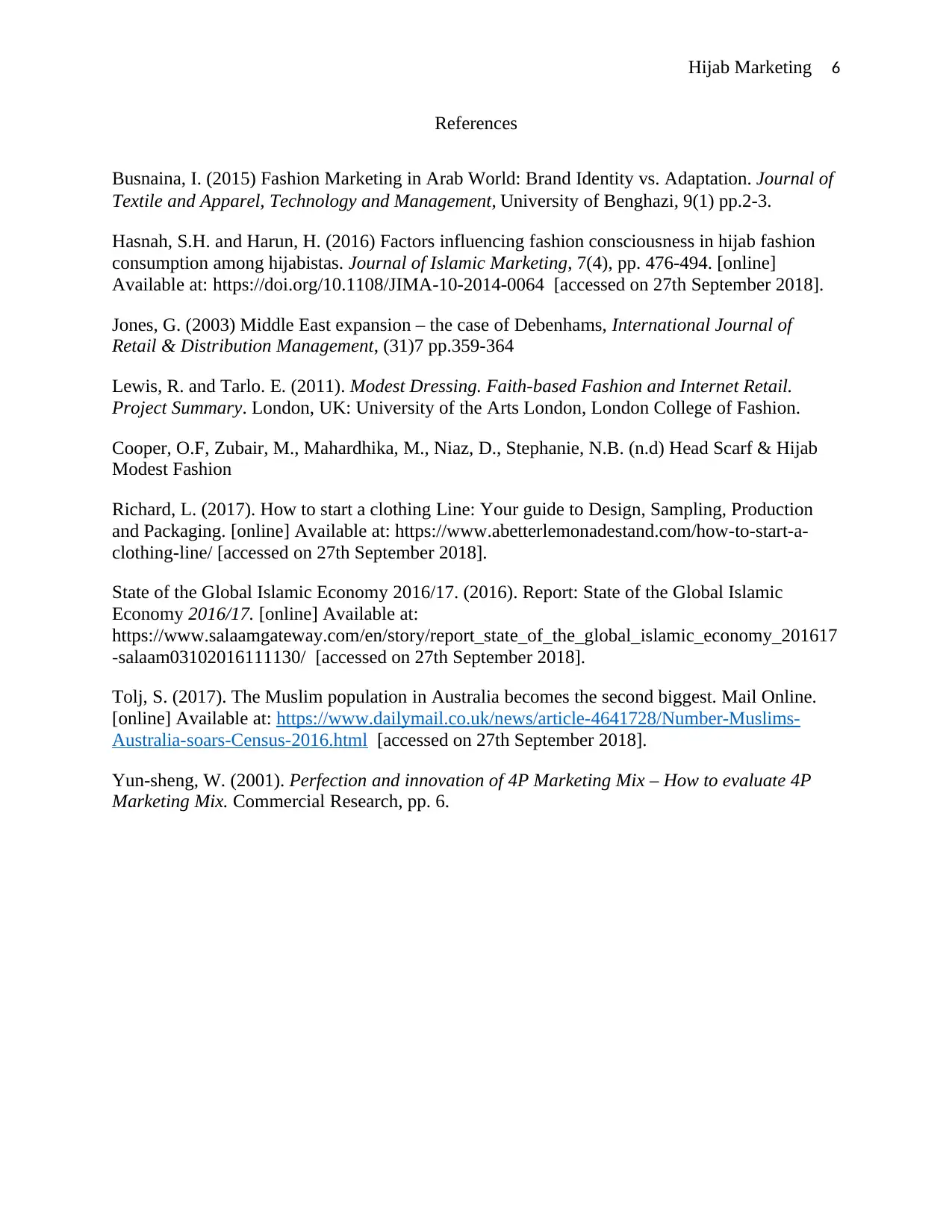
Hijab Marketing 6
References
Busnaina, I. (2015) Fashion Marketing in Arab World: Brand Identity vs. Adaptation. Journal of
Textile and Apparel, Technology and Management, University of Benghazi, 9(1) pp.2-3.
Hasnah, S.H. and Harun, H. (2016) Factors influencing fashion consciousness in hijab fashion
consumption among hijabistas. Journal of Islamic Marketing, 7(4), pp. 476-494. [online]
Available at: https://doi.org/10.1108/JIMA-10-2014-0064 [accessed on 27th September 2018].
Jones, G. (2003) Middle East expansion – the case of Debenhams, International Journal of
Retail & Distribution Management, (31)7 pp.359-364
Lewis, R. and Tarlo. E. (2011). Modest Dressing. Faith-based Fashion and Internet Retail.
Project Summary. London, UK: University of the Arts London, London College of Fashion.
Cooper, O.F, Zubair, M., Mahardhika, M., Niaz, D., Stephanie, N.B. (n.d) Head Scarf & Hijab
Modest Fashion
Richard, L. (2017). How to start a clothing Line: Your guide to Design, Sampling, Production
and Packaging. [online] Available at: https://www.abetterlemonadestand.com/how-to-start-a-
clothing-line/ [accessed on 27th September 2018].
State of the Global Islamic Economy 2016/17. (2016). Report: State of the Global Islamic
Economy 2016/17. [online] Available at:
https://www.salaamgateway.com/en/story/report_state_of_the_global_islamic_economy_201617
-salaam03102016111130/ [accessed on 27th September 2018].
Tolj, S. (2017). The Muslim population in Australia becomes the second biggest. Mail Online.
[online] Available at: https://www.dailymail.co.uk/news/article-4641728/Number-Muslims-
Australia-soars-Census-2016.html [accessed on 27th September 2018].
Yun-sheng, W. (2001). Perfection and innovation of 4P Marketing Mix – How to evaluate 4P
Marketing Mix. Commercial Research, pp. 6.
References
Busnaina, I. (2015) Fashion Marketing in Arab World: Brand Identity vs. Adaptation. Journal of
Textile and Apparel, Technology and Management, University of Benghazi, 9(1) pp.2-3.
Hasnah, S.H. and Harun, H. (2016) Factors influencing fashion consciousness in hijab fashion
consumption among hijabistas. Journal of Islamic Marketing, 7(4), pp. 476-494. [online]
Available at: https://doi.org/10.1108/JIMA-10-2014-0064 [accessed on 27th September 2018].
Jones, G. (2003) Middle East expansion – the case of Debenhams, International Journal of
Retail & Distribution Management, (31)7 pp.359-364
Lewis, R. and Tarlo. E. (2011). Modest Dressing. Faith-based Fashion and Internet Retail.
Project Summary. London, UK: University of the Arts London, London College of Fashion.
Cooper, O.F, Zubair, M., Mahardhika, M., Niaz, D., Stephanie, N.B. (n.d) Head Scarf & Hijab
Modest Fashion
Richard, L. (2017). How to start a clothing Line: Your guide to Design, Sampling, Production
and Packaging. [online] Available at: https://www.abetterlemonadestand.com/how-to-start-a-
clothing-line/ [accessed on 27th September 2018].
State of the Global Islamic Economy 2016/17. (2016). Report: State of the Global Islamic
Economy 2016/17. [online] Available at:
https://www.salaamgateway.com/en/story/report_state_of_the_global_islamic_economy_201617
-salaam03102016111130/ [accessed on 27th September 2018].
Tolj, S. (2017). The Muslim population in Australia becomes the second biggest. Mail Online.
[online] Available at: https://www.dailymail.co.uk/news/article-4641728/Number-Muslims-
Australia-soars-Census-2016.html [accessed on 27th September 2018].
Yun-sheng, W. (2001). Perfection and innovation of 4P Marketing Mix – How to evaluate 4P
Marketing Mix. Commercial Research, pp. 6.
⊘ This is a preview!⊘
Do you want full access?
Subscribe today to unlock all pages.

Trusted by 1+ million students worldwide
1 out of 6
Your All-in-One AI-Powered Toolkit for Academic Success.
+13062052269
info@desklib.com
Available 24*7 on WhatsApp / Email
![[object Object]](/_next/static/media/star-bottom.7253800d.svg)
Unlock your academic potential
Copyright © 2020–2025 A2Z Services. All Rights Reserved. Developed and managed by ZUCOL.

